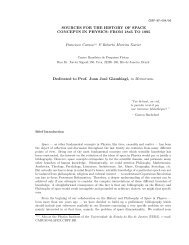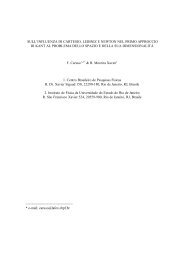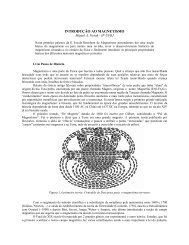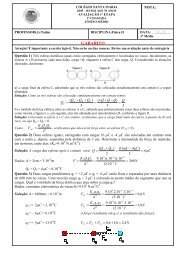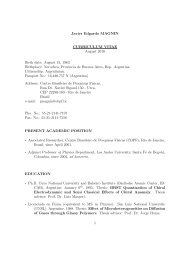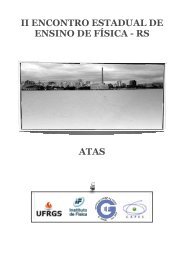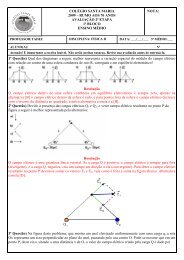Primordial non-Gaussianity in the cosmological perturbations - CBPF
Primordial non-Gaussianity in the cosmological perturbations - CBPF
Primordial non-Gaussianity in the cosmological perturbations - CBPF
You also want an ePaper? Increase the reach of your titles
YUMPU automatically turns print PDFs into web optimized ePapers that Google loves.
8πGN<br />
ρia<br />
3<br />
2 = cia −(1+3wi)<br />
, (76)<br />
for some constant ci. Then <strong>the</strong> Friedman equation takes <strong>the</strong> more explicit form<br />
˙a 2 = <br />
i<br />
cia −(1+3wi) − k + Λ<br />
3 a2 . (77)<br />
In addition to <strong>the</strong> vacuum energy (and pressure), <strong>the</strong>re are typically two o<strong>the</strong>r k<strong>in</strong>ds of matter which<br />
are relevant <strong>in</strong> our approximation, namely matter <strong>in</strong> <strong>the</strong> form of dust and radiation. Denot<strong>in</strong>g <strong>the</strong><br />
correspond<strong>in</strong>g constants by cm and cr respectively, <strong>the</strong> Friedman equation that we will be deal<strong>in</strong>g<br />
with takes <strong>the</strong> form<br />
˙a 2 = cm<br />
a<br />
cr Λ<br />
+ − k +<br />
a2 3 a2 , (78)<br />
illustrat<strong>in</strong>g <strong>the</strong> qualitatively different conntributions to <strong>the</strong> time-evolution. One can <strong>the</strong>n charac-<br />
terise <strong>the</strong> different eras <strong>in</strong> <strong>the</strong> evolution of <strong>the</strong> universe by which of <strong>the</strong> above terms dom<strong>in</strong>ates, i.e.<br />
gives <strong>the</strong> lead<strong>in</strong>g contribution to <strong>the</strong> equation of motion for a. This already gives some <strong>in</strong>sight <strong>in</strong>to<br />
<strong>the</strong> physics of <strong>the</strong> situation. We will call a universe matter-dim<strong>in</strong>ated if <strong>the</strong> piece cm/a dom<strong>in</strong>ates;<br />
radiation-dom<strong>in</strong>ated if <strong>the</strong> piece cr/a 2 dom<strong>in</strong>ates; curvature-dom<strong>in</strong>ated if <strong>the</strong> piece k dom<strong>in</strong>ates and<br />
vacuum-dom<strong>in</strong>ated if <strong>the</strong> piece Λa 2 dom<strong>in</strong>ates. As mentioned before, for a long time it was believed<br />
that our present universe is purely matter dom<strong>in</strong>ated while recent observations appear to <strong>in</strong>dicate<br />
that contributions from both matter and <strong>the</strong> <strong>cosmological</strong> constant are <strong>non</strong>-negligible.<br />
Here are some immediate consequences of <strong>the</strong> Friedman equation (78):<br />
1. No matter how small cr is, provided that it is <strong>non</strong>-zero, for sufficiently small values of a that<br />
term will dom<strong>in</strong>ate and one is <strong>in</strong> <strong>the</strong> radiation dom<strong>in</strong>ated era. In that case, one f<strong>in</strong>ds <strong>the</strong><br />
characteristic behaviour<br />
2. If matter dom<strong>in</strong>ates, one f<strong>in</strong>ds <strong>the</strong> characteristic behaviour<br />
3. For a general equation of state w = −1, one f<strong>in</strong>ds<br />
˙a 2 = cr<br />
a 2 ⇒ a(t) ∼ t1/2 (RD). (79)<br />
˙a 2 = cm<br />
a ⇒ a(t) ∼ t2/3 (MD). (80)<br />
2<br />
a(t) ∼ t 3(1+w) . (81)<br />
24




